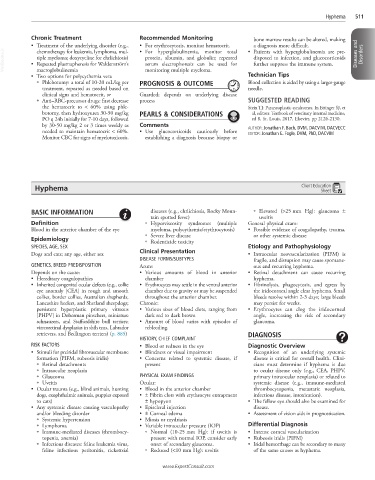Page 1034 - Cote clinical veterinary advisor dogs and cats 4th
P. 1034
Hyphema 511
Chronic Treatment Recommended Monitoring bone marrow results can be altered, making
a diagnosis more difficult.
• Treatment of the underlying disorder (e.g., • For erythrocytosis, monitor hematocrit. • Patients with hyperglobulinemia are pre-
VetBooks.ir • Repeated plasmapheresis for Waldenström’s protein, albumin, and globulin; repeated disposed to infection, and glucocorticoids Diseases and Disorders
• For hyperglobulinemia, monitor total
chemotherapy for leukemia, lymphoma, mul-
tiple myeloma; doxycycline for ehrlichiosis)
further suppress the immune system.
serum electrophoresis can be used for
macroglobulinemia
• Two options for polycythemia vera monitoring multiple myeloma. Technician Tips
○ Phlebotomy: a total of 10-20 mL/kg per PROGNOSIS & OUTCOME Blood collection is aided by using a larger-gauge
treatment, repeated as needed based on needle.
clinical signs and hematocrit, or Guarded; depends on underlying disease
○ Anti–RBC-precursor drugs: first decrease process SUGGESTED READING
the hematocrit to < 60% using phle- Stein TJ: Paraneoplastic syndromes. In Ettinger SJ, et
botomy, then hydroxyurea 30-50 mg/kg PEARLS & CONSIDERATIONS al, editors: Textbook of veterinary internal medicine,
PO q 24h initially for 7-10 days, followed ed 8, St. Louis, 2017, Elsevier, pp 2126-2130.
by 30-50 mg/kg 2 or 3 times weekly as Comments AUTHOR: Jonathan F. Bach, DVM, DACVIM, DACVECC
needed to maintain hematocrit < 60%. • Use glucocorticoids cautiously before EDITOR: Jonathan E. Fogle, DVM, PhD, DACVIM
Monitor CBC for signs of myelotoxicosis. establishing a diagnosis because biopsy or
Hyphema Client Education
Sheet
BASIC INFORMATION diseases (e.g., ehrlichiosis, Rocky Moun- ○ Elevated (>25 mm Hg): glaucoma ±
tain spotted fever) uveitis
Definition ○ Hyperviscosity syndromes (multiple General physical exam:
Blood in the anterior chamber of the eye myeloma, polycythemia/erythrocytosis) • Possible evidence of coagulopathy, trauma,
○ Severe liver disease or other systemic disease
Epidemiology ○ Rodenticide toxicity
SPECIES, AGE, SEX Etiology and Pathophysiology
Dogs and cats; any age, either sex Clinical Presentation • Intraocular neovascularization (PIFM) is
DISEASE FORMS/SUBTYPES fragile, and disruption may cause spontane-
GENETICS, BREED PREDISPOSITION Acute: ous and recurring hyphema.
Depends on the cause: • Various amounts of blood in anterior • Retinal detachment can cause recurring
• Hereditary coagulopathies chamber hyphema.
• Inherited congenital ocular defects (e.g., collie • Erythrocytes may settle in the ventral anterior • Fibrinolysis, phagocytosis, and egress by
eye anomaly [CEA] in rough and smooth chamber due to gravity or may be suspended the iridocorneal angle clear hyphema. Small
collies, border collies, Australian shepherds, throughout the anterior chamber. bleeds resolve within 2-3 days; large bleeds
Lancashire heelers, and Shetland sheepdogs; Chronic: may persist for weeks.
persistent hyperplastic primary vitreous • Various sizes of blood clots, ranging from • Erythrocytes can clog the iridocorneal
[PHPV] in Doberman pinschers, miniature dark red to dark brown angle, increasing the risk of secondary
schnauzers, and Staffordshire bull terriers; • Amount of blood varies with episodes of glaucoma.
vitreoretinal dysplasias in shih tzus, Labrador rebleeding.
retrievers, and Bedlington terriers) (p. 885) DIAGNOSIS
HISTORY, CHIEF COMPLAINT
RISK FACTORS • Blood or redness in the eye Diagnostic Overview
• Stimuli for preiridal fibrovascular membrane • Blindness or visual impairment • Recognition of an underlying systemic
formation (PIFM, rubeosis iridis) • Concerns related to systemic disease, if disease is critical for overall health. Clini-
○ Retinal detachments present cians must determine if hyphema is due
○ Intraocular neoplasia to ocular disease only (e.g., CEA, PHPV,
○ Glaucoma PHYSICAL EXAM FINDINGS primary intraocular neoplasia) or related to
○ Uveitis Ocular: systemic disease (e.g., immune-mediated
• Ocular trauma (e.g., blind animals, hunting • Blood in the anterior chamber thrombocytopenia, metastatic neoplasia,
dogs, exophthalmic animals, puppies exposed • ± Fibrin clots with erythrocyte entrapment infectious disease, intoxication).
to cats) ± hypopyon • The fellow eye should also be examined for
• Any systemic disease causing vasculopathy • Episcleral injection disease.
and/or bleeding disorder • ± Corneal edema • Assessment of vision aids in prognostication.
○ Systemic hypertension • Miosis or mydriasis
○ Lymphoma • Variable intraocular pressure (IOP) Differential Diagnosis
○ Immune-mediated diseases (thrombocy- ○ Normal (10-25 mm Hg): if uveitis is • Intense corneal vascularization
topenia, anemia) present with normal IOP, consider early • Rubeosis iridis (PIFM)
○ Infectious diseases: feline leukemia virus, onset of secondary glaucoma. • Iridal hemorrhage can be secondary to many
feline infectious peritonitis, rickettsial ○ Reduced (<10 mm Hg): uveitis of the same causes as hyphema.
www.ExpertConsult.com

